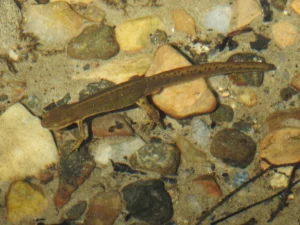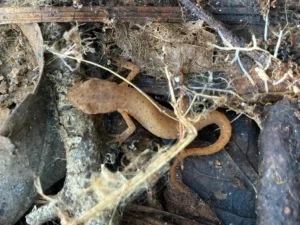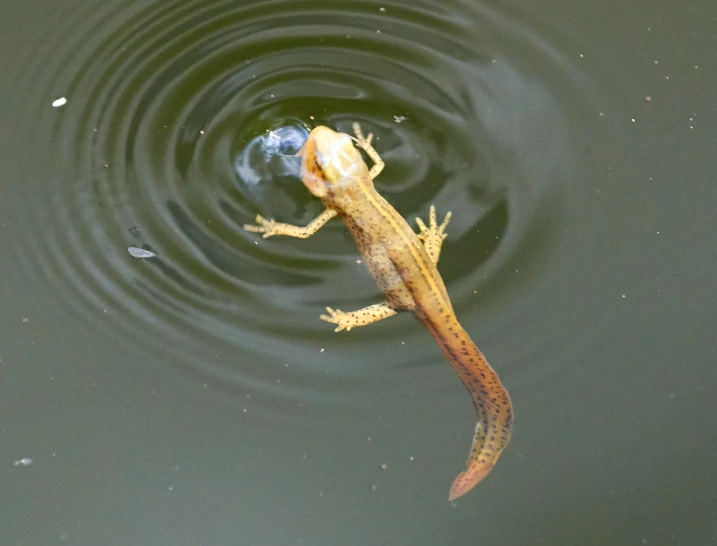You’re walking near a marsh in Florida. The air is thick, the ground damp, and dragonflies buzz around. Suddenly, a tiny creature slips out of the water and crawls onto the muddy edge.
Its skin looks smooth and moist, its tail sways, and its little legs paddle carefully forward. At first, you might think it’s a lizard. But it’s not, it’s a newt.
So, you’re probably wondering: are there newts in Florida?
Yes, Florida has newts. The one you’ll see most is the Eastern newt, which lives all over the state. These little amphibians hang out in ponds, marshes, and slow streams, and you might even spot them crossing forest paths when it’s wet.
The Eastern newt isn’t just another animal in Florida. It’s actually really interesting.
With its bright orange juvenile stage and changing lifestyle, it grabs the attention of kids exploring the woods and even scientists who study ecosystems.
Florida’s Wetlands Are Perfect for Newts
Florida is full of wetlands, such as swamps, marshes, and ponds full of life. From the huge Everglades to small hidden woodland pools, water is everywhere.
That’s exactly the kind of place newts like.
The Eastern newt likes:
-
Ponds and lakes with lots of plants.
-
Calm swamps.
-
Forests near streams with damp soil.
If you’ve seen a smooth orange or greenish creature swimming just below the surface, you might have spotted one.

They’re not flashy like alligators or herons, but they’re part of Florida’s wild scene.
The Life Stages of the Eastern Newt
Eastern newts don’t stay the same their whole life. They go through three main stages:
-
Aquatic larvae – Hatch with gills, looking like little tadpoles with legs.
-
Red eft (juvenile) – Bright orange or red, living on land for a few years.
-
Adult aquatic newt – Olive green with spots, living mostly in water again.
This changing lifestyle makes them different from other amphibians. If you’re hiking in Florida and see a tiny orange creature crawling across a damp trail, it’s probably a red eft.

Those bright colors warn predators that they’re toxic.
Where You Might See Newts in Florida
The Eastern newt is all over Florida. Some spots to look:
-
The Panhandle: Forest ponds and streams around Apalachicola National Forest.
-
Central Florida: Hidden lakes near Ocala, where kids often spot them along the water’s edge.
-
The Everglades: Less common than in the north, but they’re in calmer waters.
Basically, anywhere in Florida with clean, still water and lots of plants could be home to a newt.
Why Newts Like Florida
Florida’s warm, humid weather is perfect for amphibians. Newts need moisture for their skin, eggs, and survival.
They also need wetlands full of insects to eat. Florida has plenty of:
-
Mosquito larvae
-
Small worms
-
Tiny crustaceans
-
Aquatic insects
For a newt, Florida is like an all-you-can-eat buffet. Add in year-round warmth and shelter under logs or in water, and it’s no wonder they do well here.
Are Newts Easy to Spot?
Not really. Unlike frogs that croak loudly or alligators floating in plain sight, newts are quiet and shy.
They spend most of their time under leaves, hiding among pond plants, or swimming slowly just under the surface.

But after a heavy rain, especially in spring, you might see red efts crawling across forest paths.
They look like tiny flames moving through the leaves. That’s usually the best time to catch a glimpse.
What Newts Do in Florida’s Wetlands
Even though they’re small, newts play an important role in the ecosystem.
-
They eat insects, mosquito larvae, and tiny invertebrates, helping control pests.
-
They are food for birds, snakes, and larger fish, even with their toxins.
-
They show the water is clean, because they need clean water to survive.
Basically, newts are little messengers about the health of Florida’s wetlands.
Can You Keep Florida Newts as Pets?
Some people do, but it’s not always a good idea. Eastern newts need very specific conditions: clean water, land areas, and live food. Many don’t survive long unless someone really knows what they’re doing.
Taking wild newts also hurts local populations. It’s better to watch them in the wild than to keep them in a tank.
Threats to Florida’s Newts
Even though they’re common, newts face dangers:
-
Wetlands being drained for development takes away their homes.
-
Pollution from pesticides and fertilizers can poison them.
-
Roads mean many get crushed during wet-season migrations.
-
Pet collecting reduces wild numbers.
The biggest problem is habitat loss. As Florida grows, wetlands shrink, putting pressure on newts and other wildlife.
Newts in Florida Childhoods
Newts don’t make it onto postcards like alligators or manatees, but they’re part of growing up in Florida.
Kids flipping logs or wading in creeks often spot that flash of orange.
They might not be famous, but they’re one of Florida’s hidden wildlife treasures.
Could Non-Native Newts Cause Problems?
Native Eastern newts belong here, but exotic newts from Asia or Europe could become invasive if released. Florida’s warm climate could help them survive.
For now, it’s not a big problem, but scientists keep watch.
Florida’s wetlands are still mainly home to the native Eastern newt, and that’s a good thing.
Tips for Seeing Newts in the Wild
If you want to spot one:
-
Walk after a heavy rain in a wooded area.
-
Look at pond edges with lots of plants.
-
Check under logs or wet leaves near streams.
-
Visit state parks with clean freshwater lakes.
Patience helps. Newts move slowly, and you might only notice them when they suddenly swim or crawl out of hiding.
Conclusion
So, are there newts in Florida? Yes, for sure. The Eastern newt lives in ponds, swamps, and forests all over the state.
They might be hard to see, but once you notice them, you see how important they are.
They control insects, feed other animals, and show that the water is clean. They face threats from development and pollution, but they survive in many areas.
Next time you’re in Florida after rain, take a slow walk near a pond or forest. Look at the wet ground, and you might see a small orange eft crawling across your path.
Quietly, without making a sound, it shows you that Florida’s wild beauty isn’t always big and obvious, sometimes it’s small, slow, and hiding in plain sight.
Hi, my name is Ezra Mushala, i have been interested animals all my life. I am the main author and editor here at snakeinformer.com.

